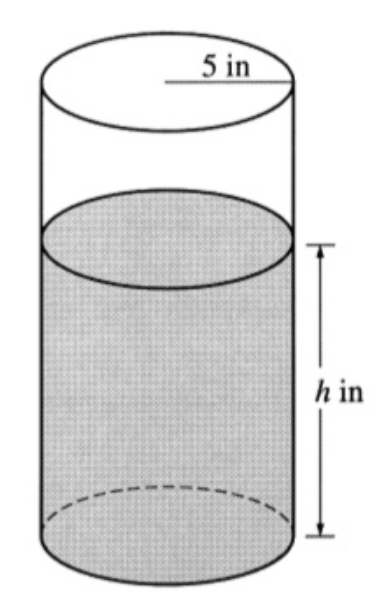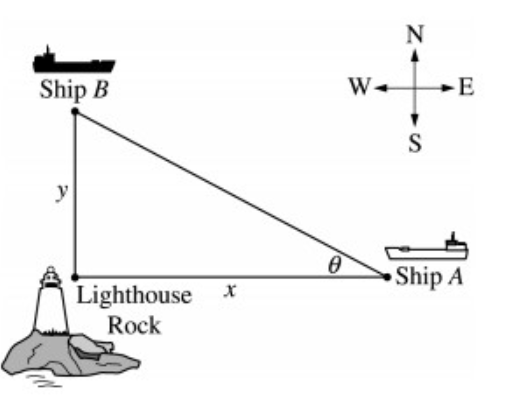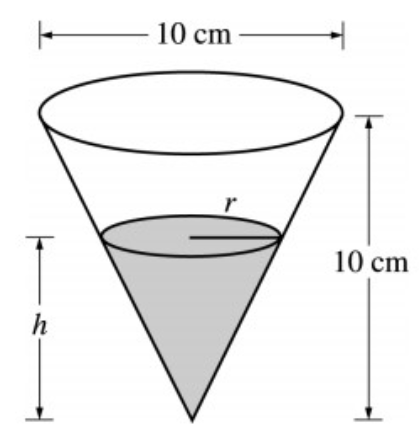Find the tangent line to the curve
f(x)=cos^2(x)
when x=0
f'(x)=-2cos(x)sin(x)
f'(0)=0
f(0)=1
y=1
Which grows faster (show proof):
f(x)=x or g(x)=3x^3
3x^3
Find the intervals of increase and decrease for the function
h(x)=x^2/2+x+5/2
Increases:
(-1,infty)
Decreases:
(-infty,-1)
Find the relative extrema for the function
g(x)=x^2-2x+3
Min:
(1, 2)
 Find the volume of water in the cylinder
Find the volume of water in the cylinder
25pih
Find the tangent line to the curve
x^2e^x
when x=1
f'(x)=e^x(x^2+2x)
f'(x)=3e
f'(1)=e
y-e=3e(x-1)
Which grows faster (show proof):
f(x)=e^x or g(x)=cos(x)
e^x
Find the intervals of increase and decrease for the function
h(x)=x^3-x^2+3
Increases:
(-infty, 0)and(2/3,infty)
Decreases:
(0,2/3)
Find the relative extrema for the function
g(x)=x^3+3/2x^2-1
Max:
(-1,-0.5)
Min:
(0,-1)
 Ship A is traveling due west toward Lighthouse Rock at a speed of 15 kilometers per hour (km/hr). Ship B is traveling due north away from Lighthouse rock at a speed of 10 km/hr. Let x be the distance between Ship A and Lighthouse Rock at time t, and let y be the distance between Ship B and Lighthouse Rock at time t, as shown in the figure above.
Ship A is traveling due west toward Lighthouse Rock at a speed of 15 kilometers per hour (km/hr). Ship B is traveling due north away from Lighthouse rock at a speed of 10 km/hr. Let x be the distance between Ship A and Lighthouse Rock at time t, and let y be the distance between Ship B and Lighthouse Rock at time t, as shown in the figure above.
Find the distance, in kilometers, between Ship A and Ship B when x = 4 km and y = 3 km
5 km
Use linearization at x=3 to approximate f(3.1) of the function
f(x)=-\sqrt (x+6)
f'(x)=(-1/2)(x+6)^(-1/2)
f'(3)=-1/6
f(3)=-3
y+3=-1/6(x-3)
y=-3.0167
Which grows faster (show proof):
f(x)=e^-x or g(x)=ln(x)
ln(x)
Find the intervals of increase and decrease for the function
h(x)=-2/(x^2+2)
Increases:
(0,infty)
Decreases:
(-infty,0)
The function f is defined by
x^2e^(-x^2)
At what values of x does f have a relative maximum?
x=-1
and
x=1
 Ship A is traveling due west toward Lighthouse Rock at a speed of 15 kilometers per hour (km/hr). Ship B is traveling due north away from Lighthouse rock at a speed of 10 km/hr. Let x be the distance between Ship A and Lighthouse Rock at time t, and let y be the distance between Ship B and Lighthouse Rock at time t, as shown in the figure above.
Ship A is traveling due west toward Lighthouse Rock at a speed of 15 kilometers per hour (km/hr). Ship B is traveling due north away from Lighthouse rock at a speed of 10 km/hr. Let x be the distance between Ship A and Lighthouse Rock at time t, and let y be the distance between Ship B and Lighthouse Rock at time t, as shown in the figure above.
Find the rate of change, in km/hr, of the distance between the two ships when x = 4 km and y = 3 km.
-6 (km)/(hr)
Use linearization at
x=pi
to approximate f(3.16) of the function
sin(x)
f'(x)=cos(x)
f'(0)=-1
f(0)=0
y=-(x-pi)
y=-0.0184
Which grows faster (show proof):
f(x)=x^e or g(x)=e^x
e^x
Find the intervals of increase and decrease for the function
h(x)=x^2e^x
Increases:
(-infty, -2)and(0,infty)
Decreases:
(-2,0)
Where does the absolute maximum value of the function
g(x)=-cos(x)-sin(x)
occur on the interval
[-2, 4]
x=4
A cube with edges of length x centimeters has volume
V(x) = x^3
cubic centimeters. The volume is increasing at a constant rate of 40 cubic centimeters per minute. At the instant when x = 2, what is the rate of change of x, in centimeters per minute, with respect to time?
10/3
Use 2 iterations of Newton's Method to approximate
6^(1/3)
1.817 (with proof)
Which grows faster (show proof):
f(x)=\sqrt(x) or g(x)=ln(x^2)
sqrt(x)
Find the intervals of increase and decrease for the function
h(x)=cot(2x) [-pi,pi]
Increases: None
Decreases:
(-pi,\pi/2),(-pi/2,0),(0,pi/2),(pi/2,pi)
What is the absolute minimum for the function
g(x)=-cos(x)-sin(x)
on the interval
[0, pi/2]
-sqrt(2)

A container has the shape of an open right circular cone, as shown in the figure above. The height of the container is 10 cm and the diameter of the opening is 10 cm. Water in the container is evaporating so that its depth h is changing at the constant rate:
(dh)/(dt)=-3/10 (cm)/(hr)
V=(1/3)pi*(r^2)*h
Find the rate of change of the volume of water in the container, with respect to time, when h = 5 cm. Indicate units of measure.
-15/8 pi (cm^3)/hr